Deck 13: Exponential Functions and Logarithmic Functions
سؤال
سؤال
سؤال
سؤال
سؤال
سؤال
سؤال
سؤال
سؤال
سؤال
سؤال
سؤال
سؤال
سؤال
سؤال
سؤال
سؤال
سؤال
سؤال
سؤال
سؤال
سؤال
سؤال
سؤال
سؤال
سؤال
سؤال
سؤال
سؤال
سؤال
سؤال
سؤال
سؤال
سؤال
سؤال
سؤال
سؤال
سؤال
سؤال
سؤال
سؤال
سؤال
سؤال
سؤال
سؤال
سؤال
سؤال
سؤال
سؤال
سؤال
سؤال
سؤال
سؤال
سؤال
سؤال
سؤال
سؤال
سؤال
سؤال
سؤال
سؤال
سؤال
سؤال
سؤال
سؤال
سؤال
سؤال
سؤال
سؤال
سؤال
سؤال
سؤال
سؤال
سؤال
سؤال
سؤال
سؤال
سؤال
سؤال
سؤال

فتح الحزمة
قم بالتسجيل لفتح البطاقات في هذه المجموعة!
Unlock Deck
Unlock Deck
1/262
العب
ملء الشاشة (f)
Deck 13: Exponential Functions and Logarithmic Functions
1
Solve the problem.
The amount of particulate matter left in solution during a filtering process decreases by the equation P(n) = where n is the number of filtering steps. Find the amounts left for n = 0 and n = 5. (Round to
where n is the number of filtering steps. Find the amounts left for n = 0 and n = 5. (Round to
The nearest whole number.)
A) 700; 22
B) 700; 88
C) 1400 ; 88
D) 700; 5600
The amount of particulate matter left in solution during a filtering process decreases by the equation P(n) =
 where n is the number of filtering steps. Find the amounts left for n = 0 and n = 5. (Round to
where n is the number of filtering steps. Find the amounts left for n = 0 and n = 5. (Round toThe nearest whole number.)
A) 700; 22
B) 700; 88
C) 1400 ; 88
D) 700; 5600
B
2
Graph.
f(x) = - 3
- 3 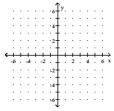
A)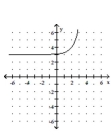
B)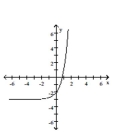
C)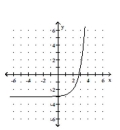
D)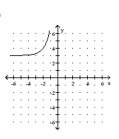
f(x) =
 - 3
- 3 
A)

B)

C)

D)

B
3
Solve the problem.
A computer is purchased for $4500. Its value each year is about 77% of the value the preceding year. Its value, in dollars, after t years is given by the exponential function V(t) = Find the value of the computer after
Find the value of the computer after
6 years.
A) $556.08
B) $20,790.00
C) $937.90
D) $722.18
A computer is purchased for $4500. Its value each year is about 77% of the value the preceding year. Its value, in dollars, after t years is given by the exponential function V(t) =
 Find the value of the computer after
Find the value of the computer after6 years.
A) $556.08
B) $20,790.00
C) $937.90
D) $722.18
C
4
Solve the problem.
Suppose that $40,000 is invested at 6% interest, compounded annually. Find a function A for the amount in the account after t years.
A)
B)
C)
D)
Suppose that $40,000 is invested at 6% interest, compounded annually. Find a function A for the amount in the account after t years.
A)

B)

C)

D)


فتح الحزمة
افتح القفل للوصول البطاقات البالغ عددها 262 في هذه المجموعة.
فتح الحزمة
k this deck
5
Solve the problem.
The number of dislocated electric impulses per cubic inch in a transformer increases when lightning strikes by D(x) = where x is the time in milliseconds of the lightning strike. Find the number of dislocated
where x is the time in milliseconds of the lightning strike. Find the number of dislocated
Impulses at x = 0 and x = 5 .
A) 2000 ; 32,000
B) 1000 ; 10,000
C) 1000 ; 32,000
D) 1000 ; 4000
The number of dislocated electric impulses per cubic inch in a transformer increases when lightning strikes by D(x) =
 where x is the time in milliseconds of the lightning strike. Find the number of dislocated
where x is the time in milliseconds of the lightning strike. Find the number of dislocatedImpulses at x = 0 and x = 5 .
A) 2000 ; 32,000
B) 1000 ; 10,000
C) 1000 ; 32,000
D) 1000 ; 4000

فتح الحزمة
افتح القفل للوصول البطاقات البالغ عددها 262 في هذه المجموعة.
فتح الحزمة
k this deck
6
Graph.
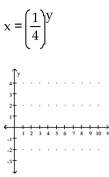
A)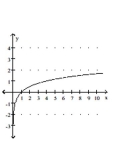
B)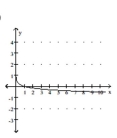
C)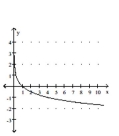
D)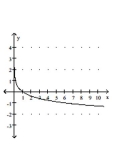

A)

B)

C)

D)


فتح الحزمة
افتح القفل للوصول البطاقات البالغ عددها 262 في هذه المجموعة.
فتح الحزمة
k this deck
7
Solve the problem.
The half-life of a certain radioactive substance is 8 years. Suppose that at time t = 0, there are 29 g of the substance. Then after t years, the number of grams of the substance remaining will be:
N(t) = How many grams of the substance will remain after 56 years? Round to the nearest hundredth when necessary.
How many grams of the substance will remain after 56 years? Round to the nearest hundredth when necessary.
A) 0.64 g
B) 1.28 g
C) 0.32 g
D) 2.56 g
The half-life of a certain radioactive substance is 8 years. Suppose that at time t = 0, there are 29 g of the substance. Then after t years, the number of grams of the substance remaining will be:
N(t) =
 How many grams of the substance will remain after 56 years? Round to the nearest hundredth when necessary.
How many grams of the substance will remain after 56 years? Round to the nearest hundredth when necessary.A) 0.64 g
B) 1.28 g
C) 0.32 g
D) 2.56 g

فتح الحزمة
افتح القفل للوصول البطاقات البالغ عددها 262 في هذه المجموعة.
فتح الحزمة
k this deck
8
Graph.
f(x) =
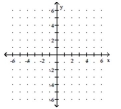
A)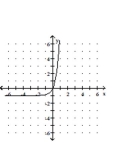
B)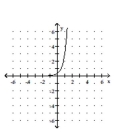
C)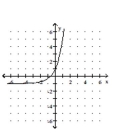
D)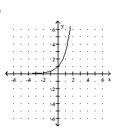
f(x) =


A)

B)

C)

D)


فتح الحزمة
افتح القفل للوصول البطاقات البالغ عددها 262 في هذه المجموعة.
فتح الحزمة
k this deck
9
Solve the problem.
An accountant tabulated a firm's profits for four recent years in the following table: The accountant then fit both a linear graph and an exponential curve (seen below) to the data, in order to estimate future profits. Use the exponential graph to estimate the profits in the year 2001.
The accountant then fit both a linear graph and an exponential curve (seen below) to the data, in order to estimate future profits. Use the exponential graph to estimate the profits in the year 2001. 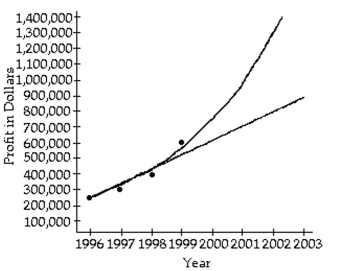
A) About $750,000
B) About $300,000
C) About $1,300,000
D) About $1,000,000
An accountant tabulated a firm's profits for four recent years in the following table:
 The accountant then fit both a linear graph and an exponential curve (seen below) to the data, in order to estimate future profits. Use the exponential graph to estimate the profits in the year 2001.
The accountant then fit both a linear graph and an exponential curve (seen below) to the data, in order to estimate future profits. Use the exponential graph to estimate the profits in the year 2001. 
A) About $750,000
B) About $300,000
C) About $1,300,000
D) About $1,000,000

فتح الحزمة
افتح القفل للوصول البطاقات البالغ عددها 262 في هذه المجموعة.
فتح الحزمة
k this deck
10
Solve the problem.
The half-life of Cesium 134m is 3.0 hours. If the formula P(t) = gives the percent (as a decimal) remaining after time t (in hours), sketch P versus t.
gives the percent (as a decimal) remaining after time t (in hours), sketch P versus t. 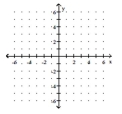
A)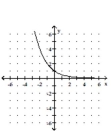
B)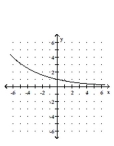
C)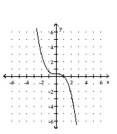
D)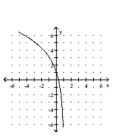
The half-life of Cesium 134m is 3.0 hours. If the formula P(t) =
 gives the percent (as a decimal) remaining after time t (in hours), sketch P versus t.
gives the percent (as a decimal) remaining after time t (in hours), sketch P versus t. 
A)

B)

C)

D)


فتح الحزمة
افتح القفل للوصول البطاقات البالغ عددها 262 في هذه المجموعة.
فتح الحزمة
k this deck
11
Solve the problem.
The number of bacteria growing in an incubation culture increases with time according to B(x) = where x is time in days. Find the number of bacteria when x = 0 and x = 3 .
where x is time in days. Find the number of bacteria when x = 0 and x = 3 .
A) 19,600 ; 78,400
B) 9800 ; 58,800
C) 9800 ; 39,200
D) 9800 ; 78,400
The number of bacteria growing in an incubation culture increases with time according to B(x) =
 where x is time in days. Find the number of bacteria when x = 0 and x = 3 .
where x is time in days. Find the number of bacteria when x = 0 and x = 3 .A) 19,600 ; 78,400
B) 9800 ; 58,800
C) 9800 ; 39,200
D) 9800 ; 78,400

فتح الحزمة
افتح القفل للوصول البطاقات البالغ عددها 262 في هذه المجموعة.
فتح الحزمة
k this deck
12
Graph.
f(x) =
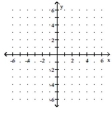
A)
B)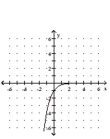
C)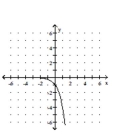
D)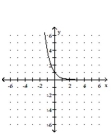
f(x) =


A)

B)

C)

D)


فتح الحزمة
افتح القفل للوصول البطاقات البالغ عددها 262 في هذه المجموعة.
فتح الحزمة
k this deck
13
Solve the problem.
An accountant tabulated a firm's profits for four recent years in the following table: The accountant then fit both a linear graph and an exponential curve (seen below) to the data, in order to estimate future profits. Use the linear graph to estimate the profits in the year 2002.
The accountant then fit both a linear graph and an exponential curve (seen below) to the data, in order to estimate future profits. Use the linear graph to estimate the profits in the year 2002. 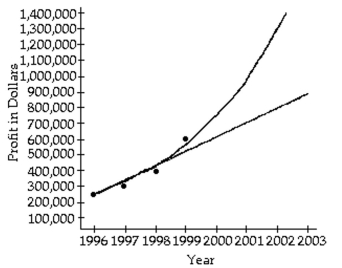
A) About $800,000
B) About $500,000
C) About $1,000,000
D) About $900,000
An accountant tabulated a firm's profits for four recent years in the following table:
 The accountant then fit both a linear graph and an exponential curve (seen below) to the data, in order to estimate future profits. Use the linear graph to estimate the profits in the year 2002.
The accountant then fit both a linear graph and an exponential curve (seen below) to the data, in order to estimate future profits. Use the linear graph to estimate the profits in the year 2002. 
A) About $800,000
B) About $500,000
C) About $1,000,000
D) About $900,000

فتح الحزمة
افتح القفل للوصول البطاقات البالغ عددها 262 في هذه المجموعة.
فتح الحزمة
k this deck
14
Graph.
f(x) = + 2
+ 2 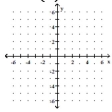
A)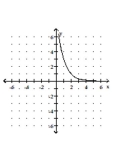
B)
C)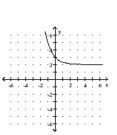
D)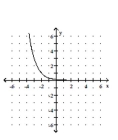
f(x) =
 + 2
+ 2 
A)

B)

C)

D)


فتح الحزمة
افتح القفل للوصول البطاقات البالغ عددها 262 في هذه المجموعة.
فتح الحزمة
k this deck
15
Graph.
f(x) =
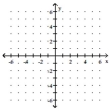
A)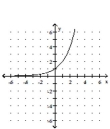
B)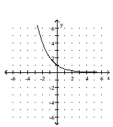
C)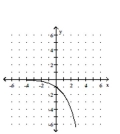
D)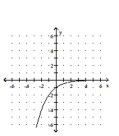
f(x) =


A)

B)

C)

D)


فتح الحزمة
افتح القفل للوصول البطاقات البالغ عددها 262 في هذه المجموعة.
فتح الحزمة
k this deck
16
Solve the problem.
An accountant tabulated a firm's profits for four recent years in the following table: The accountant then fit both a linear graph and an exponential curve (seen below) to the data, in order to estimate future profits. Use the exponential graph to estimate the profits in the year 2002.
The accountant then fit both a linear graph and an exponential curve (seen below) to the data, in order to estimate future profits. Use the exponential graph to estimate the profits in the year 2002. 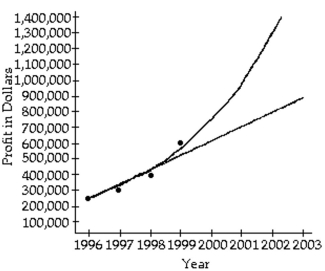
A) About $1,000,000
B) About $1,700,000
C) About $1,300,000
D) About $750,000
An accountant tabulated a firm's profits for four recent years in the following table:
 The accountant then fit both a linear graph and an exponential curve (seen below) to the data, in order to estimate future profits. Use the exponential graph to estimate the profits in the year 2002.
The accountant then fit both a linear graph and an exponential curve (seen below) to the data, in order to estimate future profits. Use the exponential graph to estimate the profits in the year 2002. 
A) About $1,000,000
B) About $1,700,000
C) About $1,300,000
D) About $750,000

فتح الحزمة
افتح القفل للوصول البطاقات البالغ عددها 262 في هذه المجموعة.
فتح الحزمة
k this deck
17
Graph.
x = 2y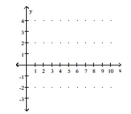
A)
B)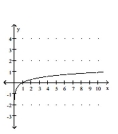
C)
D)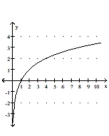
x = 2y

A)

B)

C)

D)


فتح الحزمة
افتح القفل للوصول البطاقات البالغ عددها 262 في هذه المجموعة.
فتح الحزمة
k this deck
18
Graph.
f(x) =

A)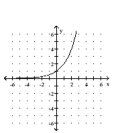
B)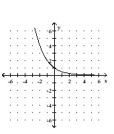
C)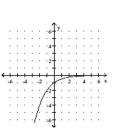
D)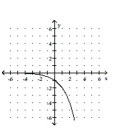
f(x) =


A)

B)

C)

D)


فتح الحزمة
افتح القفل للوصول البطاقات البالغ عددها 262 في هذه المجموعة.
فتح الحزمة
k this deck
19
Graph.
f(x) =

A)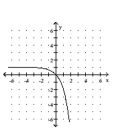
B)
C)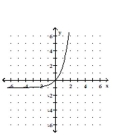
D)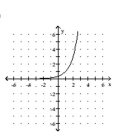
f(x) =


A)

B)

C)

D)


فتح الحزمة
افتح القفل للوصول البطاقات البالغ عددها 262 في هذه المجموعة.
فتح الحزمة
k this deck
20
Solve the problem.
An accountant tabulated a firm's profits for four recent years in the following table: The accountant then fit both a linear graph and an exponential curve (seen below) to the data, in order to estimate future profits. Use the linear graph to estimate the profits in the year 2001.
The accountant then fit both a linear graph and an exponential curve (seen below) to the data, in order to estimate future profits. Use the linear graph to estimate the profits in the year 2001. 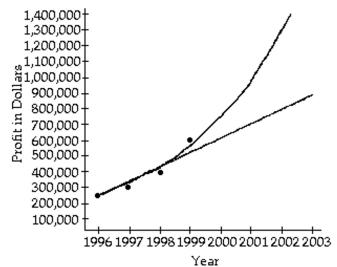
A) About $500,000
B) About $700,000
C) About $800,000
D) About $900,000
An accountant tabulated a firm's profits for four recent years in the following table:
 The accountant then fit both a linear graph and an exponential curve (seen below) to the data, in order to estimate future profits. Use the linear graph to estimate the profits in the year 2001.
The accountant then fit both a linear graph and an exponential curve (seen below) to the data, in order to estimate future profits. Use the linear graph to estimate the profits in the year 2001. 
A) About $500,000
B) About $700,000
C) About $800,000
D) About $900,000

فتح الحزمة
افتح القفل للوصول البطاقات البالغ عددها 262 في هذه المجموعة.
فتح الحزمة
k this deck
21
Find f(x) and g(x) such that h(x) = 
h(x) =
A)
B)
C)
D)

h(x) =

A)

B)

C)

D)


فتح الحزمة
افتح القفل للوصول البطاقات البالغ عددها 262 في هذه المجموعة.
فتح الحزمة
k this deck
22
Find f(x) and g(x) such that h(x) = 
h(x) =
A)
B)
C)
D)

h(x) =

A)

B)

C)

D)


فتح الحزمة
افتح القفل للوصول البطاقات البالغ عددها 262 في هذه المجموعة.
فتح الحزمة
k this deck
23
Find f(x) and g(x) such that h(x) = 
h(x) =
A)
B)
C)
D)

h(x) =

A)

B)

C)

D)


فتح الحزمة
افتح القفل للوصول البطاقات البالغ عددها 262 في هذه المجموعة.
فتح الحزمة
k this deck
24
Find the requested composition of functions.
Given f(x) = - 3 and g(x) =
- 3 and g(x) =  find
find 
A) - 3
- 3
B)
C)
D) 3
3
Given f(x) =
 - 3 and g(x) =
- 3 and g(x) =  find
find 
A)
 - 3
- 3B)

C)

D)
 3
3
فتح الحزمة
افتح القفل للوصول البطاقات البالغ عددها 262 في هذه المجموعة.
فتح الحزمة
k this deck
25
Find the inverse of the relation.
{(-5, -4), (5, 4), (-3, 6), (3, -6)}
A) {(-4, -5), (4, 5), (6, 5), (-6, 3)}
B) {(-4, -5), (4, 5), (6, -3), (-6, 3)}
C) {(-4, -5), (-5, 5), (6, -3), (-6, 3)}
{(-5, -4), (5, 4), (-3, 6), (3, -6)}
A) {(-4, -5), (4, 5), (6, 5), (-6, 3)}
B) {(-4, -5), (4, 5), (6, -3), (-6, 3)}
C) {(-4, -5), (-5, 5), (6, -3), (-6, 3)}

فتح الحزمة
افتح القفل للوصول البطاقات البالغ عددها 262 في هذه المجموعة.
فتح الحزمة
k this deck
26
Find the inverse of the relation.
{(-8, -7), (7, 8), (-4, -3), (4, 3)}
A) {(3, -4), (-4, 7), (-7, -8), (-3, 4)}
B) {(-7, -8), (8, 7), (-3, -4), (3, 4)}
C) {(3, -4), (8, 7), (-7, 7), (-3, 4)}
{(-8, -7), (7, 8), (-4, -3), (4, 3)}
A) {(3, -4), (-4, 7), (-7, -8), (-3, 4)}
B) {(-7, -8), (8, 7), (-3, -4), (3, 4)}
C) {(3, -4), (8, 7), (-7, 7), (-3, 4)}

فتح الحزمة
افتح القفل للوصول البطاقات البالغ عددها 262 في هذه المجموعة.
فتح الحزمة
k this deck
27
Find f(x) and g(x) such that h(x) = 
h(x) =
A)
B)
C)
D)

h(x) =

A)

B)

C)

D)


فتح الحزمة
افتح القفل للوصول البطاقات البالغ عددها 262 في هذه المجموعة.
فتح الحزمة
k this deck
28
Find the requested composition of functions.
Given f(x) = 7x + 8 and g(x) = 5x - 1, find
A) 35x + 39
B) 35x + 15
C) 35x + 1
D) 35x + 7
Given f(x) = 7x + 8 and g(x) = 5x - 1, find

A) 35x + 39
B) 35x + 15
C) 35x + 1
D) 35x + 7

فتح الحزمة
افتح القفل للوصول البطاقات البالغ عددها 262 في هذه المجموعة.
فتح الحزمة
k this deck
29
Find the requested composition of functions.
Given f(x) = -5x + 2 and g(x) = 2x + 4, find
A) x + 8
B) -10x + 8
C) -10x + 22
D) x - 8
Given f(x) = -5x + 2 and g(x) = 2x + 4, find

A) x + 8
B) -10x + 8
C) -10x + 22
D) x - 8

فتح الحزمة
افتح القفل للوصول البطاقات البالغ عددها 262 في هذه المجموعة.
فتح الحزمة
k this deck
30
Find f(x) and g(x) such that h(x) = 
h(x) =
A)
B)
C)
D)

h(x) =

A)

B)

C)

D)


فتح الحزمة
افتح القفل للوصول البطاقات البالغ عددها 262 في هذه المجموعة.
فتح الحزمة
k this deck
31
Find the requested composition of functions.
Given f(x) = nd g(x) = x - 3, find
nd g(x) = x - 3, find 
A)
B) - 3
- 3
C)
D)
Given f(x) =
 nd g(x) = x - 3, find
nd g(x) = x - 3, find 
A)

B)
 - 3
- 3C)

D)


فتح الحزمة
افتح القفل للوصول البطاقات البالغ عددها 262 في هذه المجموعة.
فتح الحزمة
k this deck
32
Find the inverse of the relation.
{(-16, 3), (5, -16), (-14, -12)}
A) {(-16, -16), (-16, 5), (-12, -14)}
B) {(3, -16), (-16, 5), (-12, -14)}
C) {(3, -16), (-14, 5), (-12, -16)}
{(-16, 3), (5, -16), (-14, -12)}
A) {(-16, -16), (-16, 5), (-12, -14)}
B) {(3, -16), (-16, 5), (-12, -14)}
C) {(3, -16), (-14, 5), (-12, -16)}

فتح الحزمة
افتح القفل للوصول البطاقات البالغ عددها 262 في هذه المجموعة.
فتح الحزمة
k this deck
33
Find f(x) and g(x) such that h(x) = 
h(x) =
A)
B)
C)
D)

h(x) =

A)

B)

C)

D)


فتح الحزمة
افتح القفل للوصول البطاقات البالغ عددها 262 في هذه المجموعة.
فتح الحزمة
k this deck
34
Find f(x) and g(x) such that h(x) = 
h(x) =
A)
B)
C)
D)

h(x) =

A)

B)

C)

D)


فتح الحزمة
افتح القفل للوصول البطاقات البالغ عددها 262 في هذه المجموعة.
فتح الحزمة
k this deck
35
Find f(x) and g(x) such that h(x) = 
h(x) = - 9
- 9
A)
B)
C)
D)

h(x) =
 - 9
- 9A)

B)

C)

D)


فتح الحزمة
افتح القفل للوصول البطاقات البالغ عددها 262 في هذه المجموعة.
فتح الحزمة
k this deck
36
Find the requested composition of functions.
Given f(x) = and g(x) = 7x + 10, find
and g(x) = 7x + 10, find 
A)
B) x + 20
C) 7x + 60
D) x
Given f(x) =
 and g(x) = 7x + 10, find
and g(x) = 7x + 10, find 
A)

B) x + 20
C) 7x + 60
D) x

فتح الحزمة
افتح القفل للوصول البطاقات البالغ عددها 262 في هذه المجموعة.
فتح الحزمة
k this deck
37
Find the requested composition of functions.
Given f(x) = and g(x) =
and g(x) =  find
find 
A)
B)
C)
D)
Given f(x) =
 and g(x) =
and g(x) =  find
find 
A)

B)

C)

D)


فتح الحزمة
افتح القفل للوصول البطاقات البالغ عددها 262 في هذه المجموعة.
فتح الحزمة
k this deck
38
Find f(x) and g(x) such that h(x) = 
h(x) = 7
7
A)
B)
C)
D)

h(x) =
 7
7A)

B)

C)

D)


فتح الحزمة
افتح القفل للوصول البطاقات البالغ عددها 262 في هذه المجموعة.
فتح الحزمة
k this deck
39
Find the requested composition of functions.
Given f(x) = + 8 and g(x) =
+ 8 and g(x) =  - 8, find
- 8, find 
A)
B)
C)
D)
Given f(x) =
 + 8 and g(x) =
+ 8 and g(x) =  - 8, find
- 8, find 
A)

B)

C)

D)


فتح الحزمة
افتح القفل للوصول البطاقات البالغ عددها 262 في هذه المجموعة.
فتح الحزمة
k this deck
40
Find the inverse of the relation.
{(6, 0), (-4, 1), (-6, 2), (-8, 3)}
A) {(1, 0), (3, -6), (6, -6), (1, 2)}
B) {(0, 6), (1, -4), (2, -6), (3, -8)}
C) {(1, 0), (0, -6), (6, -4), (1, 2)}
{(6, 0), (-4, 1), (-6, 2), (-8, 3)}
A) {(1, 0), (3, -6), (6, -6), (1, 2)}
B) {(0, 6), (1, -4), (2, -6), (3, -8)}
C) {(1, 0), (0, -6), (6, -4), (1, 2)}

فتح الحزمة
افتح القفل للوصول البطاقات البالغ عددها 262 في هذه المجموعة.
فتح الحزمة
k this deck
41
Find an equation of the inverse of the relation.
y =
A)
B)
C)
D)
y =

A)

B)

C)

D)


فتح الحزمة
افتح القفل للوصول البطاقات البالغ عددها 262 في هذه المجموعة.
فتح الحزمة
k this deck
42
Find an equation of the inverse of the relation.
y = 4 + 6x
A) y = 6 - 4x
B) y = 6 + 4x
C) x = 6 + 4y
D) x = 4 + 6y
y = 4 + 6x
A) y = 6 - 4x
B) y = 6 + 4x
C) x = 6 + 4y
D) x = 4 + 6y

فتح الحزمة
افتح القفل للوصول البطاقات البالغ عددها 262 في هذه المجموعة.
فتح الحزمة
k this deck
43
Determine whether the function is one-to-one.
-f(x) = - 2
- 2
-f(x) =
 - 2
- 2
فتح الحزمة
افتح القفل للوصول البطاقات البالغ عددها 262 في هذه المجموعة.
فتح الحزمة
k this deck
44
Graph the equation of the relation using a solid line, and then graph the inverse of the relation using a dashed line.
y =
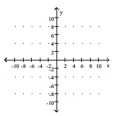
A)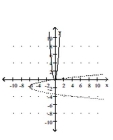
B)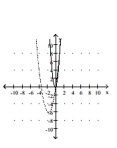
C)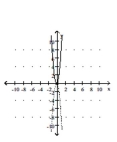
D)
y =


A)

B)

C)

D)


فتح الحزمة
افتح القفل للوصول البطاقات البالغ عددها 262 في هذه المجموعة.
فتح الحزمة
k this deck
45
Graph the relation using solid circles and the inverse using open circles.
{(-3, -12), (-5, -11), (-7, -10), (-9, -9)}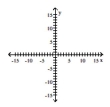
A)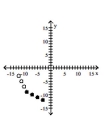
B)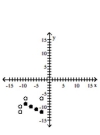
C)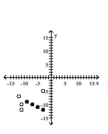
D)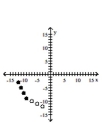
{(-3, -12), (-5, -11), (-7, -10), (-9, -9)}

A)

B)

C)

D)


فتح الحزمة
افتح القفل للوصول البطاقات البالغ عددها 262 في هذه المجموعة.
فتح الحزمة
k this deck
46
Determine whether the function is one-to-one.
-f(x) = + x
+ x
-f(x) =
 + x
+ x
فتح الحزمة
افتح القفل للوصول البطاقات البالغ عددها 262 في هذه المجموعة.
فتح الحزمة
k this deck
47
Graph the relation using solid circles and the inverse using open circles.
{(-6, 7), (-7, 6), (-9, -4), (9, 4)}
A)
B)
C)
D)
{(-6, 7), (-7, 6), (-9, -4), (9, 4)}

A)

B)

C)

D)


فتح الحزمة
افتح القفل للوصول البطاقات البالغ عددها 262 في هذه المجموعة.
فتح الحزمة
k this deck
48
Determine whether the function is one-to-one.
-f(x) = - 6
- 6
-f(x) =
 - 6
- 6
فتح الحزمة
افتح القفل للوصول البطاقات البالغ عددها 262 في هذه المجموعة.
فتح الحزمة
k this deck
49
Graph the relation using solid circles and the inverse using open circles.
{(-9, 3), (9, -3), (-7, -1), (7, 1)}
A)
B)
C)
D)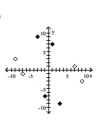
{(-9, 3), (9, -3), (-7, -1), (7, 1)}

A)

B)

C)

D)


فتح الحزمة
افتح القفل للوصول البطاقات البالغ عددها 262 في هذه المجموعة.
فتح الحزمة
k this deck
50
Find an equation of the inverse of the relation.
y = + 5x
+ 5x
A)
B)
C)
D)
y =
 + 5x
+ 5xA)

B)

C)

D)


فتح الحزمة
افتح القفل للوصول البطاقات البالغ عددها 262 في هذه المجموعة.
فتح الحزمة
k this deck
51
Determine whether the function is one-to-one.
-f(x) = - 6
- 6
-f(x) =
 - 6
- 6
فتح الحزمة
افتح القفل للوصول البطاقات البالغ عددها 262 في هذه المجموعة.
فتح الحزمة
k this deck
52
Determine whether the function is one-to-one.
-f(x) = + 8
+ 8
-f(x) =
 + 8
+ 8
فتح الحزمة
افتح القفل للوصول البطاقات البالغ عددها 262 في هذه المجموعة.
فتح الحزمة
k this deck
53
Determine whether the function is one-to-one.
-f(x) =
-f(x) =


فتح الحزمة
افتح القفل للوصول البطاقات البالغ عددها 262 في هذه المجموعة.
فتح الحزمة
k this deck
54
Determine whether the function is one-to-one.
-f(x) = 6x - 6
-f(x) = 6x - 6

فتح الحزمة
افتح القفل للوصول البطاقات البالغ عددها 262 في هذه المجموعة.
فتح الحزمة
k this deck
55
Graph the equation of the relation using a solid line, and then graph the inverse of the relation using a dashed line.
y = 2 + 3x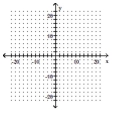
A)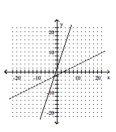
B)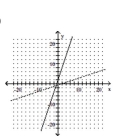
C)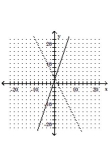
D)
y = 2 + 3x

A)

B)

C)

D)


فتح الحزمة
افتح القفل للوصول البطاقات البالغ عددها 262 في هذه المجموعة.
فتح الحزمة
k this deck
56
Graph the equation of the relation using a solid line, and then graph the inverse of the relation using a dashed line.
y = 7x - 8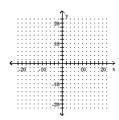
A)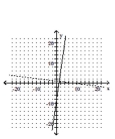
B)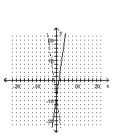
C)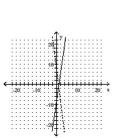
D)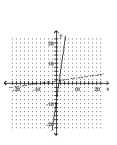
y = 7x - 8

A)

B)

C)

D)


فتح الحزمة
افتح القفل للوصول البطاقات البالغ عددها 262 في هذه المجموعة.
فتح الحزمة
k this deck
57
Graph the relation using solid circles and the inverse using open circles.
{(-1, 16), (-7, -2), (5, -11)}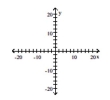
A)
B)

C)
D)

{(-1, 16), (-7, -2), (5, -11)}

A)
B)


C)
D)



فتح الحزمة
افتح القفل للوصول البطاقات البالغ عددها 262 في هذه المجموعة.
فتح الحزمة
k this deck
58
Graph the equation of the relation using a solid line, and then graph the inverse of the relation using a dashed line.
y =
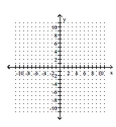
A)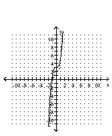
B)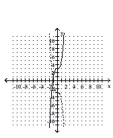
C)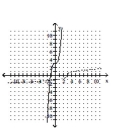
D)
y =


A)

B)

C)

D)


فتح الحزمة
افتح القفل للوصول البطاقات البالغ عددها 262 في هذه المجموعة.
فتح الحزمة
k this deck
59
Find an equation of the inverse of the relation.
y = 2x - 7
A) y = -2x + 7
B) y = -7x + 2
C) x = 2y - 7
D) x = -7y + 2
y = 2x - 7
A) y = -2x + 7
B) y = -7x + 2
C) x = 2y - 7
D) x = -7y + 2

فتح الحزمة
افتح القفل للوصول البطاقات البالغ عددها 262 في هذه المجموعة.
فتح الحزمة
k this deck
60
Determine whether the function is one-to-one.
-f(x) = 64 -
-f(x) = 64 -


فتح الحزمة
افتح القفل للوصول البطاقات البالغ عددها 262 في هذه المجموعة.
فتح الحزمة
k this deck
61
Graph the function as a solid curve and its inverse as a dashed curve.
f(x) =
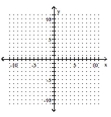
A)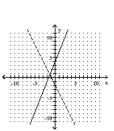
B)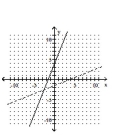
C)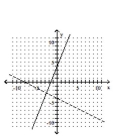
D)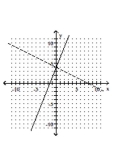
f(x) =


A)

B)

C)

D)


فتح الحزمة
افتح القفل للوصول البطاقات البالغ عددها 262 في هذه المجموعة.
فتح الحزمة
k this deck
62
Solve the problem.
A size 12 dress in Country C is size 44 in Country D. A function that converts dress sizes in Country C to those in Country D is f(x) = x + 32. Find a formula for the inverse of the function described.
A)
B)
C)
D)
A size 12 dress in Country C is size 44 in Country D. A function that converts dress sizes in Country C to those in Country D is f(x) = x + 32. Find a formula for the inverse of the function described.
A)

B)

C)

D)


فتح الحزمة
افتح القفل للوصول البطاقات البالغ عددها 262 في هذه المجموعة.
فتح الحزمة
k this deck
63
Use composition to verify whether or not the inverse is correct.
-
-


فتح الحزمة
افتح القفل للوصول البطاقات البالغ عددها 262 في هذه المجموعة.
فتح الحزمة
k this deck
64
Use composition to verify whether or not the inverse is correct.
-
-


فتح الحزمة
افتح القفل للوصول البطاقات البالغ عددها 262 في هذه المجموعة.
فتح الحزمة
k this deck
65
Determine whether the function is one-to-one.
-f(x) =
-f(x) =


فتح الحزمة
افتح القفل للوصول البطاقات البالغ عددها 262 في هذه المجموعة.
فتح الحزمة
k this deck
66
Determine whether the given function is one-to-one. If so, find a formula for the inverse.
f(x) =
A)
B)
C) Not a one-to-one function
D)
f(x) =

A)

B)

C) Not a one-to-one function
D)


فتح الحزمة
افتح القفل للوصول البطاقات البالغ عددها 262 في هذه المجموعة.
فتح الحزمة
k this deck
67
Use composition to verify whether or not the inverse is correct.
-
-


فتح الحزمة
افتح القفل للوصول البطاقات البالغ عددها 262 في هذه المجموعة.
فتح الحزمة
k this deck
68
Determine whether the given function is one-to-one. If so, find a formula for the inverse.
f(x) =
A)
B)
C) Not a one-to-one function
D)
f(x) =

A)

B)

C) Not a one-to-one function
D)


فتح الحزمة
افتح القفل للوصول البطاقات البالغ عددها 262 في هذه المجموعة.
فتح الحزمة
k this deck
69
Use composition to verify whether or not the inverse is correct.
-
-


فتح الحزمة
افتح القفل للوصول البطاقات البالغ عددها 262 في هذه المجموعة.
فتح الحزمة
k this deck
70
Determine whether the given function is one-to-one. If so, find a formula for the inverse.
f(x) =
A)
B)
C) Not a one-to-one function
D)
f(x) =

A)

B)

C) Not a one-to-one function
D)


فتح الحزمة
افتح القفل للوصول البطاقات البالغ عددها 262 في هذه المجموعة.
فتح الحزمة
k this deck
71
Solve the problem.
A size -10 dress in Country C is size -10 in Country D. A function that converts dress sizes in Country C to those in Country D is f(x) = x - 20. Find a formula for the inverse of the function described.
A)
B)
C)
D)
A size -10 dress in Country C is size -10 in Country D. A function that converts dress sizes in Country C to those in Country D is f(x) = x - 20. Find a formula for the inverse of the function described.
A)

B)

C)

D)


فتح الحزمة
افتح القفل للوصول البطاقات البالغ عددها 262 في هذه المجموعة.
فتح الحزمة
k this deck
72
Determine whether the given function is one-to-one. If so, find a formula for the inverse.
f(x) =
A) Not a one-to-one function
B)
C)
D)
f(x) =

A) Not a one-to-one function
B)

C)

D)


فتح الحزمة
افتح القفل للوصول البطاقات البالغ عددها 262 في هذه المجموعة.
فتح الحزمة
k this deck
73
Graph the function as a solid curve and its inverse as a dashed curve.
f(x) =

A)
B)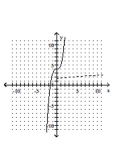
C)
D)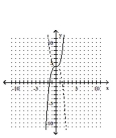
f(x) =


A)

B)

C)

D)


فتح الحزمة
افتح القفل للوصول البطاقات البالغ عددها 262 في هذه المجموعة.
فتح الحزمة
k this deck
74
Determine whether the given function is one-to-one. If so, find a formula for the inverse.
f(x) = 4x + 3
A)
B)
C)
D) Not a one-to-one function
f(x) = 4x + 3
A)

B)

C)

D) Not a one-to-one function

فتح الحزمة
افتح القفل للوصول البطاقات البالغ عددها 262 في هذه المجموعة.
فتح الحزمة
k this deck
75
Use composition to verify whether or not the inverse is correct.
-
-


فتح الحزمة
افتح القفل للوصول البطاقات البالغ عددها 262 في هذه المجموعة.
فتح الحزمة
k this deck
76
Use composition to verify whether or not the inverse is correct.
-
-


فتح الحزمة
افتح القفل للوصول البطاقات البالغ عددها 262 في هذه المجموعة.
فتح الحزمة
k this deck
77
Determine whether the given function is one-to-one. If so, find a formula for the inverse.
f(x) =
A)
B)
C) Not a one-to-one function
D)
f(x) =

A)

B)

C) Not a one-to-one function
D)


فتح الحزمة
افتح القفل للوصول البطاقات البالغ عددها 262 في هذه المجموعة.
فتح الحزمة
k this deck
78
Determine whether the given function is one-to-one. If so, find a formula for the inverse.
f(x) =
A)
B) Not a one-to-one function
C)
D)
f(x) =

A)

B) Not a one-to-one function
C)

D)


فتح الحزمة
افتح القفل للوصول البطاقات البالغ عددها 262 في هذه المجموعة.
فتح الحزمة
k this deck
79
Use composition to verify whether or not the inverse is correct.
-
-


فتح الحزمة
افتح القفل للوصول البطاقات البالغ عددها 262 في هذه المجموعة.
فتح الحزمة
k this deck
80
Graph the function as a solid curve and its inverse as a dashed curve.
f(x) = 2x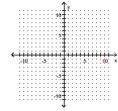
A)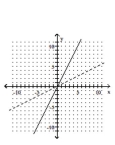
B)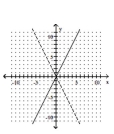
C)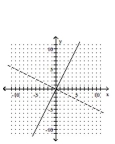
D)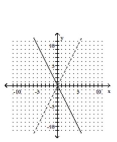
f(x) = 2x

A)

B)

C)

D)


فتح الحزمة
افتح القفل للوصول البطاقات البالغ عددها 262 في هذه المجموعة.
فتح الحزمة
k this deck








